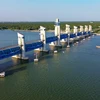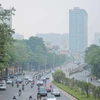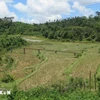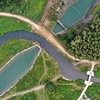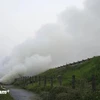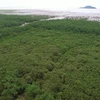As one of the countries that will endure the worst impacts of climate change, Vietnam has been comprehensively preparing to mitigate the troubles that lie ahead.
According to a report from the Central Committee for Flood and Storm Control, in the last 15 years natural calamities such as storms, flash floods, landslides, drought and salt intrusion have left 10,711 dead or missing and taken away 1.5 percent from GDP each year.
In its Political Platform on developing the country in the transitional period toward socialism, revised in 2011, the Communist Party of Vietnam pledged to seriously research and forecast the impacts of climate change and implement solutions to limit these risks.
Resultantly, the National Assembly and Government have developed and issued many policies and laws, gradually creating a legal framework and policy environment.
Laws and regulations already enforced include the National Strategy for Disaster Prevention , Response and Mitigation to 2020; the Irrigation Development Strategy to 2020; the Hydrometeorology Development Strategy; the Green Growth Strategy; the Water Resources Law; and the National Strategy and National Plan of Action on Climate Change.
A National Committee on Climate Change has been formed to coordinate inter-sector efforts to implement these strategies. Meanwhile, the Government has allocated further funds enabling additional scientific and technological research on climate change to take place.
Loans with favourable interest rates and non-refundable assistance from international organisations and foreign governments, totalling over 500 million USD since 2010, have been channelled into the climate change response.
Localities themselves have taken advantage of local contributions from individuals and political-social organisations for search and rescue and disaster relief.
Vietnam has achieved progress in international cooperation and integration for its climate change response, earning recognition from its partners and drawing more assistance.
The Climate Change and Rising Sea Levels Scenarios for Vietnam, which was introduced by the Ministry of Natural Resources and Environment (MoNRE) in June 2009, and updated on March 2012, provides an important basis for assessing the likely impacts of climate change, and the national plan of action used this as an important tool.
Nguyen Van Tue, Director of the Department of Hydrometeorology and Climate Change under the MoNRE, said that disaster prevention and mitigation has been strengthened and achieved progress in line with the climate change threat.
In addition, Vietnam so far has implemented 160 projects under the clean development mechanism (CDM) dictated by the Tokyo Protocol and has been granted a total of nearly 7 million certified emissions reduction units (CER).
The country is ranked fourth in the world in terms of its number of CDM projects, and ninth for the number of CER units it has.-VNA
According to a report from the Central Committee for Flood and Storm Control, in the last 15 years natural calamities such as storms, flash floods, landslides, drought and salt intrusion have left 10,711 dead or missing and taken away 1.5 percent from GDP each year.
In its Political Platform on developing the country in the transitional period toward socialism, revised in 2011, the Communist Party of Vietnam pledged to seriously research and forecast the impacts of climate change and implement solutions to limit these risks.
Resultantly, the National Assembly and Government have developed and issued many policies and laws, gradually creating a legal framework and policy environment.
Laws and regulations already enforced include the National Strategy for Disaster Prevention , Response and Mitigation to 2020; the Irrigation Development Strategy to 2020; the Hydrometeorology Development Strategy; the Green Growth Strategy; the Water Resources Law; and the National Strategy and National Plan of Action on Climate Change.
A National Committee on Climate Change has been formed to coordinate inter-sector efforts to implement these strategies. Meanwhile, the Government has allocated further funds enabling additional scientific and technological research on climate change to take place.
Loans with favourable interest rates and non-refundable assistance from international organisations and foreign governments, totalling over 500 million USD since 2010, have been channelled into the climate change response.
Localities themselves have taken advantage of local contributions from individuals and political-social organisations for search and rescue and disaster relief.
Vietnam has achieved progress in international cooperation and integration for its climate change response, earning recognition from its partners and drawing more assistance.
The Climate Change and Rising Sea Levels Scenarios for Vietnam, which was introduced by the Ministry of Natural Resources and Environment (MoNRE) in June 2009, and updated on March 2012, provides an important basis for assessing the likely impacts of climate change, and the national plan of action used this as an important tool.
Nguyen Van Tue, Director of the Department of Hydrometeorology and Climate Change under the MoNRE, said that disaster prevention and mitigation has been strengthened and achieved progress in line with the climate change threat.
In addition, Vietnam so far has implemented 160 projects under the clean development mechanism (CDM) dictated by the Tokyo Protocol and has been granted a total of nearly 7 million certified emissions reduction units (CER).
The country is ranked fourth in the world in terms of its number of CDM projects, and ninth for the number of CER units it has.-VNA

